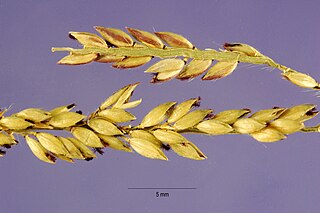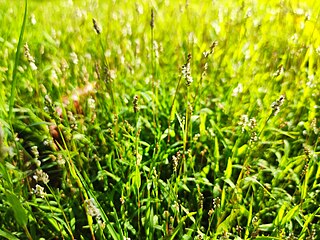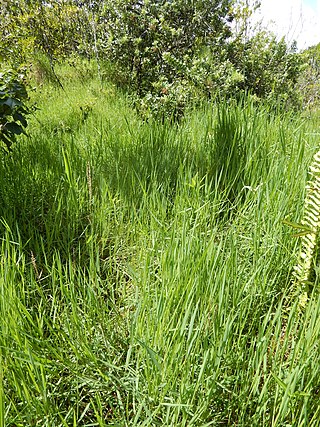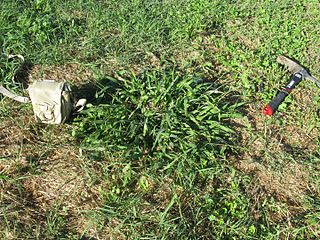
Terminalia is a genus of large trees of the flowering plant family Combretaceae, comprising nearly 300 species distributed in tropical regions of the world. The genus name derives from the Latin word terminus, referring to the fact that the leaves appear at the very tips of the shoots.

Echinochloa is a very widespread genus of plants in the grass family and tribe Paniceae. Some of the species are known by the common names barnyard grass or cockspur grass.

Urochloa panicoides is a fodder grass originating in Southern Africa.

Eriochloa is a widespread genus of plants in the grass family, commonly called cupgrass. They are found across much of Africa, Asia, Australia, and the Americas, plus a few places in European Russia.

Oldeania alpina, the African alpine bamboo, is a perennial bamboo of the family Poaceae and the genus Oldeania. It can be found growing in dense but not large stands on the mountains and volcanoes surrounding the East African Rift between 2,500 meters and 3,300 meters elevation.

Acroceras is a genus of tropical and subtropical plants in the grass family.

Schmidtia is a genus of Asian and African plants in the grass family.

Urochloa, commonly known as signalgrass, is a genus of plants in the grass family, native to tropical and subtropical regions of Eurasia, Africa, Australia, the Americas, and various islands.

Setaria verticillata is a species of grass known by the common names hooked bristlegrass, rough bristle-grass and bristly foxtail. It is native to Europe, but it is known on most continents as an introduced species and often a noxious weed. It is a hardy bunchgrass which grows in many types of urban, cultivated, and disturbed habitat. It is a weed of many types of agricultural crops, growing in vineyards and fields. Herbicide-resistant strains have been noted.

Urochloa brizantha is a species of grass known by the common name palisade grass. It is often used as a forage for livestock. Other common names include palisade signal grass, bread grass, Mauritius grass, Surinam grass, large-seeded millet grass, big ashama, Ceylon sheep grass, and St. Lucia grass.
Urochloa eminii, commonly known as Congo grass, is a species of forage crop in the family Poaceae that is grown throughout the humid tropics. With fast growth at the beginning of the wet season due to strong seedling vigour, ease of establishment, good seed production and yield and the ability to suppress weeds it has the ability to become developed into the most important forage crop planted in the tropics. With the aid of genomic tools to research the genotype and gain more information there is the ability to increase breeding programs which are currently rather limited.

Urochloa mutica, commonly known as para grass, buffalo grass, Mauritius signal grass, pasto pare, malojilla, gramalote, parana, Carib grass, and Scotch grass, is a species of grass. Despite its common name of California grass, it does not occur in California; it is native to northern and central Africa and parts of the Middle East, where it is cultivated for fodder. It was introduced elsewhere and it is now cultivated throughout tropical regions of the world for this purpose.
Stipagrostis hirtigluma is a densely tufted perennial grass. It occurs across most of Africa east to Pakistan in bushveld, karoo, and desert regions. In Namibia, it grows in dry, warm parts, in stony or sandy places and on rocky outcrops.

Hemarthria altissima, variously called limpo grass, limpograss, halt grass, Batavian quick grass, swamp couch grass, red swamp grass and red vleigrass, is a species of flowering plant in the jointgrass genus Hemarthria, family Poaceae. It is native to the Old World Tropics and Subtropics; Africa, Southern Europe, the Middle East, India, Southeast Asia, eastern China, and Borneo, and widely introduced as a forage in the New World, from Texas and Florida south to northern Argentina. In addition to being a valued forage for livestock, it makes a good, fragrant silage. A number of cultivars are commercially available.

Digitaria abyssinica, the East African couchgrass, is a species of flowering plant in the family Poaceae. It is native to Sub‑Saharan Africa, Madagascar, many of the Indian Ocean islands, the Arabian Peninsula, Sri Lanka, Peninsular Malaysia, Vietnam, New Guinea, and Queensland in Australia, and it has been introduced to scattered locations in Central America and northern South America, and to Saint Helena. Although it is a livestock forage, albeit a low‑quality one, it is generally considered a noxious weed.

Hyperthelia dissoluta, the yellow thatching grass, is a species of flowering plant in the family Poaceae. It is native to Sub‑Saharan Africa and Madagascar. It has been introduced to Mexico, Central America, Colombia, and Brazil. Its palatability to livestock decreases markedly as the plant matures, and it is a very aggressive competitor, so it has developed a bad reputation among ranchers.

Urochloa ramosa, the browntop millet or Dixie signalgrass, is an annual, millet grass belonging to the grass family (Poaceae). The native range of Urochloa ramosa is from Africa to tropical and subtropical Asia.
Urochloa deflexa, commonly known as Guinea millet, is an annual millet grass belonging to the grass family (Poaceae). It is native to many regions such as Africa, India, and Pakistan in both tropical and subtropical regions. It has been used as a supplemental food source among other cereal crops.

Cenchrus setiger, the birdwood grass, is a species in the grass family Poaceae. It native to drier parts of Africa, the Arabian Peninsula, Iran, India, and as far as Myanmar, and has been introduced to the United States, Brazil, and Australia. Drought-tolerant and quite palatable to livestock, it is a valuable fodder and forage in areas that get as little as 200 mm of rain per year, but its productivity is low.

Urochloa trichopus, bushveld signal grass is a species of grass that is native to tropical and southern parts of Africa, Arabian Peninsula and western Madagascar.

















